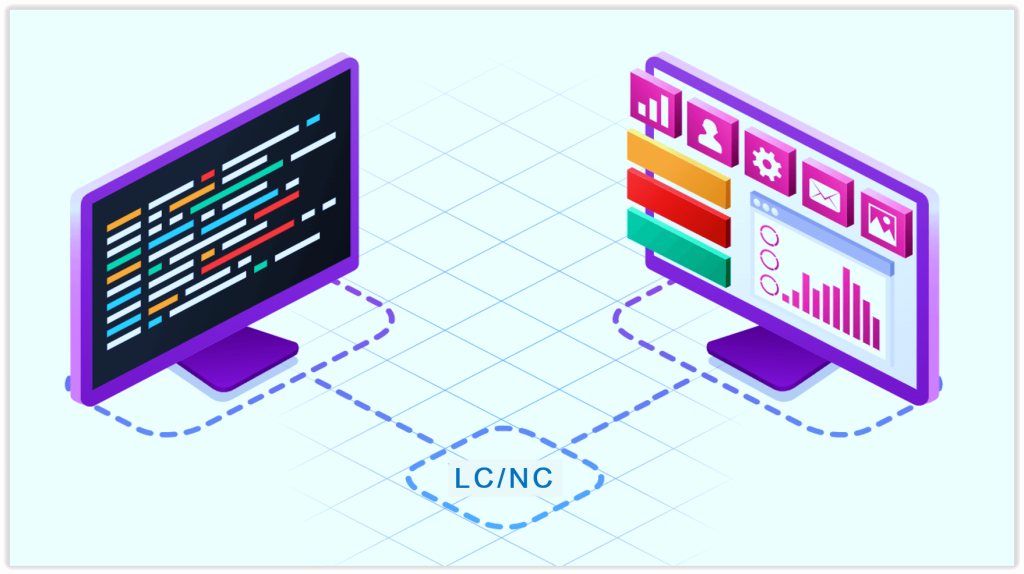Content Attributes
In the fast-paced world of software development, new approaches are constantly emerging to streamline the process and make it more accessible to a broader audience. Two such methodologies gaining popularity are low-code and no-code development. These innovative approaches enable individuals with limited technical expertise to build software applications quickly and efficiently. In this blog post, we will explore what low-code and no-code development entails, their benefits, and some key considerations for using these development methods.
What is Low-Code Development?
Low-code development is a software development approach that emphasizes visual modeling and abstraction to accelerate the application development process. It is designed to simplify the creation of applications by reducing the need for hand-coding and technical expertise. In a low-code development environment, developers use drag-and-drop components and pre-built templates to assemble applications quickly.
Key Characteristics of Low-Code Development:
- Visual Modeling: Low-code platforms typically offer visual interfaces, allowing developers to design applications by simply dragging and dropping components onto a canvas. This visual approach abstracts complex coding tasks, making it easier for non-technical users to participate in the development process.
- Reusability: Low-code platforms often come with a library of pre-built components and templates. Developers can reuse these components across multiple projects, saving time and effort.
- Integration Capabilities: Low-code platforms usually provide integration with various third-party services and APIs. This enables seamless integration with external systems, such as databases, cloud services, and enterprise software.
- Flexibility: While low-code platforms provide visual abstractions, they also allow developers to incorporate custom code when necessary. This flexibility ensures that complex functionalities can still be achieved if not readily available in the pre-built components.
What is No-Code Development?
No-code development takes the concept of low-code development a step further by removing the need for any coding or programming knowledge. It empowers individuals with little to no technical background to create functional software applications using intuitive interfaces and simple tools.
Key Characteristics of No-Code Development:
- Intuitive Interfaces: No-code platforms offer user-friendly interfaces that require little technical knowledge to navigate. Users can build applications by selecting from a range of pre-designed templates and widgets.
- WYSIWYG (What You See Is What You Get): With a WYSIWYG editor, users can design and customize their applications visually. They can see the changes in real-time as they build the application, eliminating the need for writing code or debugging.
- Rapid Prototyping: No-code development allows users to quickly prototype and iterate on their ideas, making it an excellent tool for testing and validating concepts.
- Accessibility: No-code development opens up application development to a broader audience, including business users, entrepreneurs, and non-technical professionals.
Benefits of Low-Code and No-Code Development:

- Faster Time-to-Market: The visual and abstracted nature of low-code and no-code development expedites the application development process. This allows organizations to bring products to market quicker, giving them a competitive edge.
- Cost-Efficiency: With reduced reliance on professional developers, low-code and no-code development can significantly lower development costs. Organizations can allocate resources more efficiently and maximize their return on investment.
- Empowerment of Citizen Developers: Low-code and no-code development empower individuals with diverse backgrounds to actively participate in the development process. This democratization of software development fosters innovation and creativity.
- Iterative Development: Both approaches support rapid prototyping and iteration. This enables continuous improvement and refinement of applications based on user feedback and changing requirements.
- Bridging the IT Skills Gap: The shortage of skilled developers has been a challenge for many organizations. Low-code and no-code development offer a viable solution by enabling business users and non-technical professionals to build applications independently.
Key Considerations for Using Low-Code and No-Code Development:
- Scope and Complexity: While low-code and no-code development can handle many use cases, they may not be suitable for highly complex or large-scale applications. Consider the scope and complexity of your project to ensure that the chosen approach aligns with your needs.
- Integration Requirements: Evaluate the integration capabilities of the platform. Ensure that it supports seamless integration with the systems and services you need to connect with.
- Security and Compliance: Security is a critical concern when developing software applications. Ensure that the low-code or no-code platform adheres to industry security standards and provides robust data protection features.
- Vendor Support and Scalability: Choose a reputable vendor that provides reliable support and continuous updates for the platform. Additionally, consider the scalability of the solution to accommodate future growth and increased application complexity.
- Training and Support: Providing adequate training and support to citizen developers is essential for the successful adoption of low-code and no-code development. Invest in training programs to empower users and help them leverage the platform effectively.
As low-code and no-code development continue to gain traction in the software development industry. It’s crucial to delve deeper into the potential challenges and future implications of these methodologies.
Challenges of Low-Code and No-Code Development:
- Limited Customization: While low-code and no-code platforms offer pre-built components and templates, they may have limitations in customizability. Advanced or highly specific requirements may require custom code, which can be challenging for non-technical users.
- Performance Concerns: In some cases, the abstraction and automation offered by these platforms might result in less optimized code, leading to potential performance issues. Careful consideration of performance requirements is essential, especially for resource-intensive applications.
- Vendor Lock-In: Adopting a specific low-code or no-code platform could lead to vendor lock-in, making it difficult to migrate to another solution in the future. Organizations should carefully assess the long-term implications and potential exit strategies.
- Learning Curve: While low-code and no-code platforms aim to be user-friendly. There is still a learning curve, especially for those who are new to application development. Adequate training and resources are necessary to help users overcome initial challenges.
- Not Suitable for All Projects: Low-code and no-code development excel in certain use cases. Such as rapid prototyping, internal tools, and simple applications. However, complex or mission-critical projects may still require traditional development methods for optimal results.
Future Implications:
- Democratization of Software Development: Low-code and no-code development empower individuals across various domains to participate actively in the software development process. This democratization has the potential to foster innovation and drive digital transformation in organizations.
- Augmented Development Teams: Rather than replacing traditional developers, low-code and no-code platforms can augment development teams. Professional developers can focus on complex tasks, while citizen developers handle simpler projects, leading to increased productivity.
- Increased Innovation and Agility: With low-code and no-code development, organizations can rapidly prototype and test new ideas, allowing them to experiment and innovate more freely. This agility can help organizations stay ahead in a dynamic and competitive market.
- Addressing the IT Skills Gap: The shortage of skilled developers has been a persistent challenge for many industries. Low-code and no-code development provide a potential solution by enabling non-technical users to contribute to application development, easing the burden on IT teams.
- Evolving Platform Capabilities: Low-code and no-code platforms are continually evolving to address the needs of a diverse user base. We can expect these platforms to become more sophisticated, offering a broader range of functionalities and integration options.
Conclusion:
Low-code and no-code development have emerged as game-changers in the software development landscape. Offering a promising future for organizations seeking faster and more accessible ways to build applications. The benefits of empowering citizen developers, increase innovation. And addressing the IT skills gap makes these methodologies an attractive option for many businesses.
However, it’s essential to carefully assess project requirements, and consider potential challenges. And choose the right platform that aligns with the organization’s needs and long-term goals. By striking a balance between low-code, no-code, and traditional development methods. Organizations can harness the full potential of these approaches to create efficient, user-friendly, and impactful software applications.
As technology evolves, low-code and no-code development will undoubtedly continue to shape the way we build digital solutions. Embracing these methodologies and staying abreast of the latest advancements will ensure that businesses remain competitive. Agile, and well-equipped to meet the ever-changing demands of the digital world.



